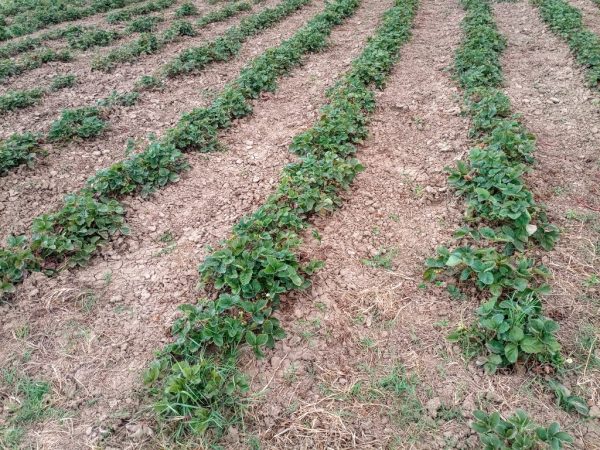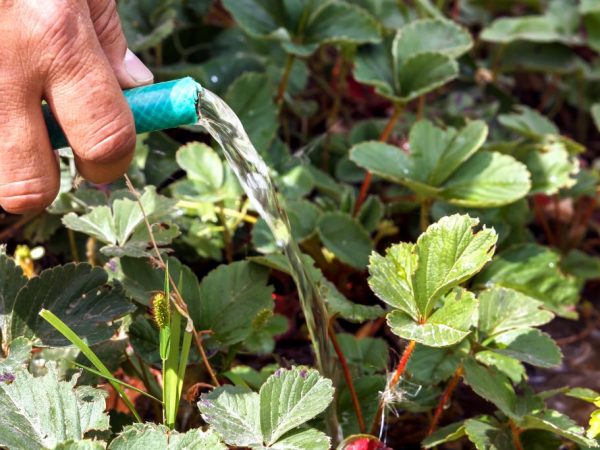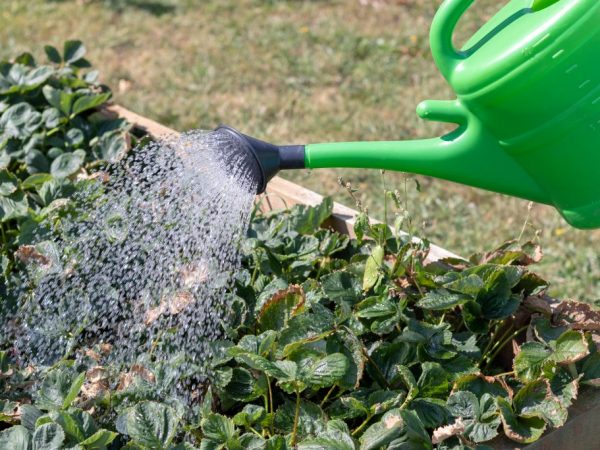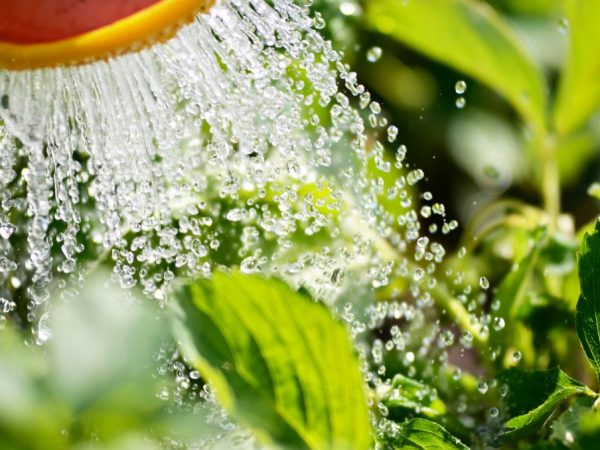Autumn feeding of strawberries - rules, timing and dosage
After the end of the fruiting period, strawberries need a balanced diet in order to safely survive the winter and give a good harvest the next year. Consider how to feed strawberries in the fall, and what time it is best to do it.

Autumn feeding of strawberries - rules, timing and dosage
What are autumn dressings for?
The degree of frost resistance of plants depends on the frequency and correct application of fertilizers. Autumn dressings increase the immunity of strawberries from various diseases and pests.
The bushes, fed with useful microelements, will yield a good harvest of tasty and large berries for the next year.
Basic Rules:
- strict adherence to dosage and dietary regimen;
- processing in cloudy and calm weather, or in the evening when the sun goes down;
- combined with watering to prevent root burning and improve the quality of nutrient absorption;
- loosening after moistening.
During the autumn feeding, nitrogen is not needed - it stimulates the growth of green mass and inhibits the development of the root system. Such bushes will not have time to prepare for wintering and will freeze.
Fertilization timing
You can fertilize the bushes in the fall at the end of fruiting, because the processed berries cannot be eaten, they become toxic.
Depending on the type of plant, the timing is different:
- for common varieties - during September;
- remontant is best fed in the period from mid-October to early November.
Organic fertilizers
Strawberries respond positively to organics - eating chicken droppings, slurry, mullein, yeast has a beneficial effect on growth and further fruiting.

Organics increase yields
These components take a long time to decompose and show the maximum effect in the spring.
| Application time | Fertilizer type | Rules and dosage |
| One week after picking berries | Liquid horse or cow manure | 8 liters of water for 2 kg of manure, insist for three days. Before use, the concentrated solution is diluted with water in a ratio of 1:10. Poured under the root within two days after preparation. Then the soil is loosened. |
| After harvest in September | Yeast | For 50 g of live yeast, 1 liter of warm water is required. The resulting composition is brought to a volume of 5 liters. Spill each bush under the root. The second recipe is to add 0.5 kg of wet yeast, 500 g of stale bread to 70 liters of water. Insist for two days, filter. Consumption - 1 liter per one seedling. |
| After pruning the bushes | Chicken droppings | 10 liters of water will require 3 liters of substance. Insist for 3 days, dilute 1 liter of the working mixture in 20 liters of water. Watered at the root. Consumption - 0.5 l per plant. |
| In the fall, a month before the onset of cold weather | Wood ash | Sprinkle ash between the rows and the soil under the bushes. For 1 m², 150 g is enough. You can also use a liquid solution - 200 g of the substance will be required for 10 liters of water. Insist day. Consumption - 1 liter per one seedling. |
| On the eve of autumn frosts | Slurry | Take a container with a volume of 10 liters, fill it with 1/3 slurry, then fill it with water to the top. Insist 1-2 weeks. The composition is diluted with water in a ratio of 1:10. |
| A week before the first persistent cold weather | Humus | Rotten manure contains many microorganisms and nutrients for strawberries. Top dressing must be applied for digging or loosening in a dry form |
| After wintering, in early spring | Urea | This fertilizer contains a high nitrogen content. Promotes intensive growth of green mass, flower buds and whiskers, which has a beneficial effect on increasing the yield. Recipe: 15 g of substance per 10 liters of water. Feed in the evening or in cloudy weather - 0.5 liters per bush. |
Mineral fertilizers

Mineral fertilizers are suitable for all varieties
The main care of strawberries in the fall includes the periodic introduction of mineral preparations that increase winter hardiness, strengthen the root system and help plants maintain health until spring.
These dressings are suitable for feeding all varieties, including the remontant variety.
| Application time | Fertilizer type | Rules and dosage |
| After the end of fruiting, in September - for common varieties; At the end of October or at the beginning of November - for remontants. | Complex composition of superphosphate and potassium sulfate | Take 15 g of each component in a bucket of water. 1 liter of working fluid is poured under one plant, then loosening is carried out. |
| After wintering, when the outside temperature stabilizes | Nitrogen substances | 3 types of solution:
Processing is carried out between the rows in the evening. |
| After trimming the whiskers and leaves | Potassium sulphate | 30 g of the substance is diluted in 10 l of water. This preparation increases the frost resistance of the crop and provides good disease resistance. |
| When preparing strawberries in autumn in September or October, 3 weeks before the first frost | Superphosphate | There are two options:
Top dressing is applied after watering, in the evening. |
Some gardeners feed the strawberry plantation for the winter with a complex composition of organic and mineral substances:
- Dissolve 250 g of wood ash in a bucket of warm water;
- add 3 tablespoons of nitrophoska;
- at the end, mixed with 30 g of potash fertilizer.
Each bush should be fed with such a complex at the rate of 0.5 liters per copy. They are used for both regular and remontant varieties.

Top dressing helps plants to winter
After trimming the leaves, strawberries can be fed with a solution of pale pink potassium permanganate. For this, a spray is used so that the treatment is of high quality - throughout the above-ground part.
Immediately after foliar fertilization, wet bushes are sprinkled with wood ash. Repeat the procedure after 3 weeks.
Signs of missing items
Determine the lack or excess of trace elements by the external state of the stems and leaves.
Nitrogen
If not, the plants form small and pale leaves in summer. Bushes grow slowly, bloom poorly and bear fruit. This usually happens with crops growing on acidic, cold and waterlogged soil.
When overfeeding, strawberries intensively increase their green mass, which inhibits flowering and berry formation.
Superphosphate
A sign of a shortage - the leaves become smaller, the old ones are covered with a brownish bloom, the productivity of the bushes decreases.
The deficiency of this component increases if organic fertilizing is not applied for 2-3 years.
Potassium
With a deficiency, the leaves acquire a bluish-green color, fade, contain elements of a reddish tone. Leaf plates wrinkle, grow unevenly. Berries ripen less aromatic, their taste deteriorates.
Strawberries planted on peat, sandy and sandy loam soils must be fed with this microelement 2-3 times per season.
Copper
There is not enough copper, the leaves become variegated, wither, turn pale, the tops of the shoots die off, the growth of the aerial part slows down. This phenomenon occurs on young seedlings, especially during extreme heat and drought.
Plantations planted on sandy and acidic soils usually suffer from a shortage.
Manganese
With a shortage, elements of chlorosis appear on the upper leaves, as with iron deficiency. Leaves often fall off. This happens when grown on acidic and alkaline soils.
Calcium
If the strawberry lacks calcium, the leaves become covered with chlorotic stripes, the edges curl, the aerial part stops growing and developing.
In excess, the green mass turns yellow intensively, while the veins remain green.
Usually, a deficit is noted on red earth, podzolic and peat lands.
Boron
Due to the lack of leaves, the leaves become small, curl, the veins turn red, necrotic spots appear. Strawberries bloom poorly and give a tasteless harvest, the berries become smaller.
From the excess, the intoxication of the bushes occurs - they turn yellow, dry out.
It is better to apply boric fertilizers together with deoxidizing components (calcite, dolomite flour, slaked lime) and a complex composition of phosphorus, potassium and nitrogen.
Conclusion
To increase the yield for the next year, to ensure high-quality wintering and good resistance to diseases and parasites, strawberries should be fed with different compositions in the fall.
Observing the scheme, dosage, timing of application, it will be possible to grow a healthy and strong crop, which will give a good harvest in summer.

